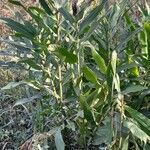Pseudostems 1--3 m. Leaves sessile; ligule 2--3 cm, membranous; leaf blade oblong-lanceolate or lanceolate, 20--40 × 4.5--8 cm, adaxially glabrous, abaxially finely pubescent or thinly hairy, base acute, apex long acuminate. Spikes ellipsoid, 10--20 × 4--8 cm; bracts imbricate, ovate, 4.5--5 × 2.5--4 cm, 2-or 3-flowered. Flowers white, fragrant. Calyx ca. 4 cm, split on 1 side. Corolla tube ca. 8 cm, slender; lobes lanceolate, ca. 5 cm, central one spatulate, apex mucronate. Lateral staminodes oblong-lanceolate, ca. 5 cm. Labellum white, pale yellow at base, obcordate, 4--6 × 4--6 cm, apex 2-cleft. Filament ca. 3 cm; anther ca. 1.5 cm. Ovary sericeous. Fl. Aug--Dec. 2 n = 34.
An upright herb in the ginger family. It can be 3 m tall and spread to 1 m across. It has rhizomes under the ground. The leaves do not have stalks. The leaves are long pointed and sword shaped. They can be 20-40 cm long by 4.5-8 cm wide and are mid green in colour. They are downy underneath. The flowers are butterfly like and white. The flowers occur around stalks on the top of the plant. These flower clusters can be 10-20 cm long by 4-8 cm wide. There are 2-3 flowers and they have a sweet smell.
Leaf blades oblanceolate or narrowly elliptic, 28--48 ´ 4--7 cm. Inflorescences erect, 15--19 ´ 12--17 cm; bracts of main axis green; proximal bracts ovate, concave, 4--5.5 ´ 2--4.5 cm, apex obtuse or apiculate; distal bracts lance-oblong or ovate, 4--6 ´ 1--2.5 cm, apex rounded or apiculate. Flowers: perianth and staminodes white.
Plant to 3 m tall. Leaves lanceolate, acuminate, to 60 cm long and 11 cm wide. Inflorescence c. 20 cm long, 11 cm wide; bracts broad, imbricate, each subtending 2–6 flowers. Flowers white. Labellum usually yellow-green centrally. Filament white.










